-
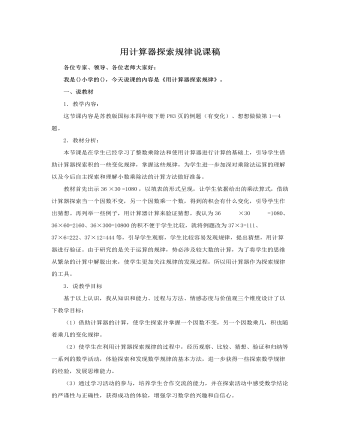
人教版新课标小学数学五年级上册用计算器探索规律说课稿
(3)补充题:2008年的奥运会在北京举行,小明的爸爸决定去北京观看一些比赛项目,为中国健儿加油。如果坐汽车,每小时行使60千米,4小时可以多少千米?如果坐火车,火车的速度是汽车的2倍,同样的时间可以行使多少千米?这题的第2个问题中蕴含着两种解题思路,让学生说一说、比一比。一种是根据速度×时间=路程的数量关系,先算出变化了的那个因数是多少,再求积。另一种是根据一个因数不变,另一个因数乘以几,原来的积也乘以几解决问题。两种方法得出的积相同,使学生体会积的变化规律是客观存在的普遍规律。『设计理念』在层次分明,形式多样的练习中,通过让学生想一想、填一填、说一说,使学生在规律的应用中逐步加深对积的变化规律的理解。
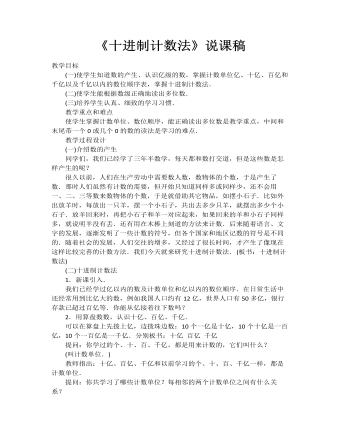
小学数学人教版四年级上册《十进制计数法》说课稿
(二)十进制计数法1.新课引入.我们已经学过亿以内的数及计数单位和亿以内的数位顺序.在日常生活中还经常用到比亿大的数,例如我国人口约有12亿,世界人口有50多亿,银行存款已超过百亿等.你能从亿接着往下数吗?2.用算盘数数,认识十亿、百亿、千亿.可以在算盘上先拨上亿,边拨珠边数:10个一亿是十亿,10个十亿是一百亿,10个一百亿是一千亿.分别板书:十亿 百亿 千亿提问:你学过的个、十、百、千亿,都是用来计数的,它们叫什么?(叫计数单位.)教师指出:十亿、百亿、千亿和以前学习的个、十、百、千亿一样,都是计数单位.
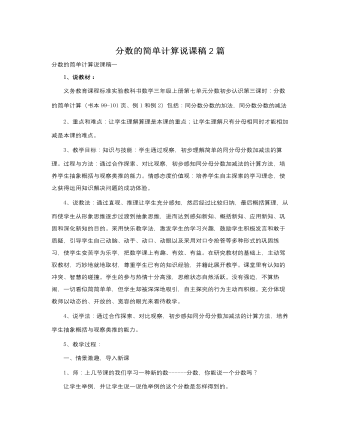
人教版新课标小学数学三年级上册分数的简单计算说课稿2篇
四,说教学过程(一)基本功训练:通过2分钟口算练习以及听,说,动的训练,提高学生的口算能力及运算速度,培养学生的听,说,动的学习习惯.缓解学生的紧张情绪.(二)情景激趣,导入新课.通过谈话,同学们喜欢吃水果吗吃水果能吃出数学问题.这是出示例1的情境图,让学生说一说他们吃出了什么数学问题.这样设计的意图是通过学生自己观察发现数学信息,提出数学问题,培养学生解决问题的意识和能力,培养学生抓住有价值的数学信息的能力.(三)探究同分母分数加法.看到黑板上的和你想到了什么(比大,分母相同,根据这个分数你们能提个问题吗)这是注重培养学生多思考,多表达,在语言表达中深化对前面学习过知识的理解.发展学生的语言表达能力.
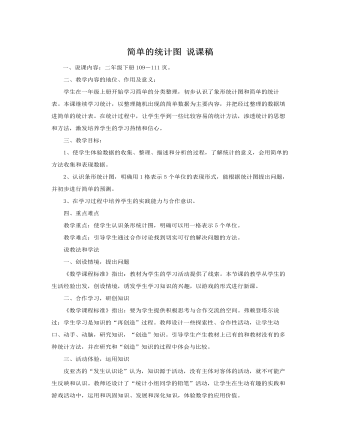
人教版新课标小学数学二年级下册简单的统计图说课稿
学生在一年级上册开始学习简单的分类整理,初步认识了象形统计图和简单的统计表。本课继续学习统计,以整理随机出现的简单数据为主要内容,并把经过整理的数据填进简单的统计表。在统计过程中,让学生学到一些比较容易的统计方法,渗透统计的思想和方法,激发培养学生的学习热情和信心。三、教学目标:1、使学生体验数据的收集、整理、描述和分析的过程,了解统计的意义,会用简单的方法收集和表现数据。2、认识条形统计图,明确用1格表示5个单位的表现形式,能根据统计图提出问题,并初步进行简单的预测。3、在学习过程中培养学生的实践能力与合作意识。四、重点难点教学重点:使学生认识条形统计图,明确可以用一格表示5个单位。教学难点:引导学生通过合作讨论找到切实可行的解决问题的方法。
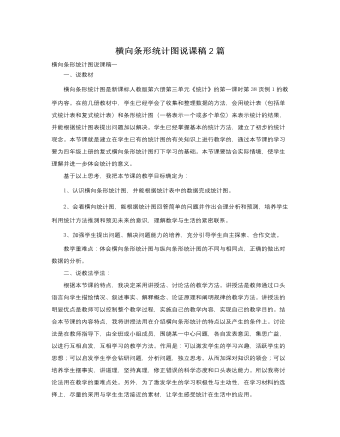
人教版新课标小学数学三年级下册横向条形统计图说课稿2篇
(设计意图:这样一来,学生的设计方案可能是很开放的,例如,有的学生只是把纵向条形统计图进行90度旋转,得到的横向统计图横轴与纵轴的方向始终与规范的统计图不一致(其实,这些“统计图”也同样反映这些数据的状况,只是不够规范而已)。让学生自主探索、交流合作,得出结论。这样可以极大地调动学生学习的兴趣。培养学生的迁移类推能力和合作交流的能力。)2、比较并介绍横向条形统计图产生的条件A、(出示完整的横向条形统计图与纵向条形统计图)他们有什么不同?又有什么相同的?把自己的发现跟同桌说说。(根据学生的回答板书:横轴:数据;纵轴:项目)B、(生回答后)小结揭题:只是竖着的变成横着了,但是内容没变,只是形状变了。这就是我们今天学习的“横向条形统计图”(板书)。它一般在统计报表中出现,有时竖着画不下的时候我们可以横着画出这样的统计图。
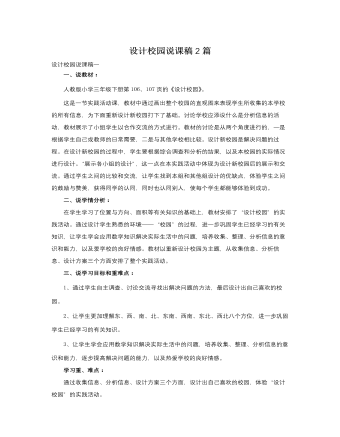
人教版新课标小学数学三年级下册设计校园说课稿2篇
二、说学情分析:在学生学习了位置与方向、面积等有关知识的基础上,教材安排了“设计校园”的实践活动。通过设计学生熟悉的环境──“校园”的过程,进一步巩固学生已经学习的有关知识,让学生学会应用数学知识解决实际生活中的问题,培养收集、整理、分析信息的意识和能力,以及爱学校的良好情感。教材以重新设计校园为主题,从收集信息、分析信息、设计方案三个方面安排了整个实践活动。三、说学习目标和重难点:1、通过学生自主调查、讨论交流寻找出解决问题的方法,最后设计出自己喜欢的校园。2、让学生更加理解东、西、南、北、东南、西南、东北、西北八个方位,进一步巩固学生已经学习的有关知识。3、让学生学会应用数学知识解决实际生活中的问题,培养收集、整理、分析信息的意识和能力,逐步提高解决问题的能力,以及热爱学校的良好情感。
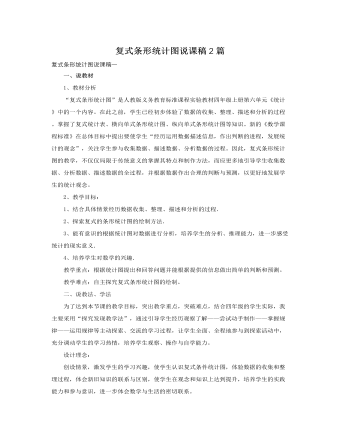
人教版新课标小学数学四年级上册复式条形统计图说课稿2篇
同时又大大地节省了教学时间,提高了课堂效率。第五个层次:尝试制作复式条形统计图教师导语:在我们的生活中经常都会用到“复式条形统计图”,下面是四年级同学参加体育活动项目的情况统计表,大家有兴趣根据其中提供的信息制作一张复式条形统计图吗?展示书119页例题3,1、让学生观察统计表,读取其中信息2、让学生根据信息补充统计图。让学生一边说,老师一边用课件演示涂色过程。对于此处教学,我们所做统计图都是提供了横轴和纵轴的,学生只需读取信息,在表格中画出相应的直条。所以难度大大降低。可以说是一种半放手的“制作过程”,同时教学中让学生说,老师演示,也是一个半放手的教与学。只是为下一环节中,学生完全有自己独立收集数据,选取颜色画直条补充统计图搭脚手架。
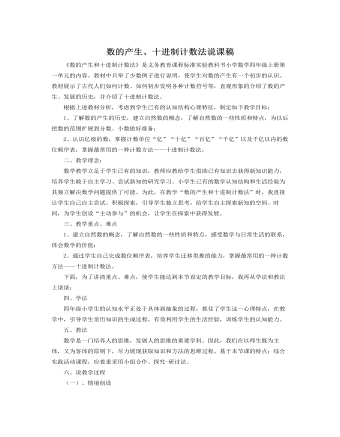
人教版新课标小学数学四年级上册数的产生、十进制计数法说课稿
2、十进制计数法(1)、师提问:“同学们,我们在前几节课已经学习了到万级为止的数,但是,还有比亿更大的数存在着,(出示数位顺序表):引导学生利用已有的知识进行类推,将已学过的亿以内数位顺序表扩展到“千亿”。教师在计数器上现场贴上亿级的数位。(教师向学生说明:还有比千亿更大的数,由于不常用,暂时不学,因此在数为顺序表后面用“…”,表示后面还有其他数位。)(2)、教师提问:“那么,我们已经学习了哪些计数单位呢?”(3)、小组讨论:“每相邻的两个计数单位之间的进率是多少?”请同学们自己得出结论:每相邻的两个计数单位之间的进率都是十。最后,教师给出“十进制计数法”的名称,在黑板上板书。(三)、课堂总结1、教师:“同学们,今天我们一起学习了?”教师请同学们接下去说完整:“自然数和十进制计数法。”
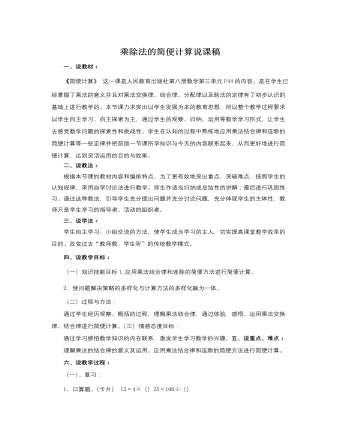
人教版新课标小学数学四年级下册乘除法的简便计算说课稿
一、说教材:《简便计算》 这一课是人民教育出版社第八册数学第三单元P44的内容。是在学生已经掌握了乘法的意义并且对乘法交换律、结合律、分配律以及除法的定律有了初步认识的基础上进行教学的。本节课力求突出以学生发展为本的教育思想,所以整个教学过程要求以学生自主学习、自主探索为主,通过学生的观察、归纳、运用等数学学习形式,让学生去感受数学问题的探索性和挑战性。学生在认知的过程中熟练地应用乘法结合律和连除的简便计算等一些定律并把前面一节课所学知识与今天的内容联系起来,从而更好地进行简便计算,达到灵活运用的目的与效果。二、说教法:根据本节课的教材内容和编排特点,为了更有效地突出重点,突破难点,按照学生的认知规律,采用自学讨论法进行教学。师生作适当归纳或总结性的讲解;最后进行巩固练习。通过这种教法,引导学生充分提出问题并充分讨论问题,充分体现学生的主体性,教师只是学生学习的指导者、活动的组织者。
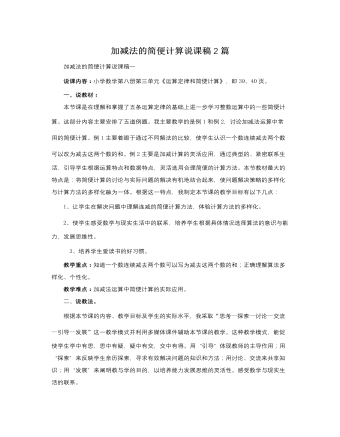
人教版新课标小学数学四年级下册加减法的简便计算说课稿2篇
一、说教材:本节课是在理解和掌握了五条运算定律的基础上进一步学习整数运算中的一些简便计算。这部分内容主要安排了五道例题。我主要教学的是例1和例2,讨论加减法运算中常用的简便计算。例1主要着眼于通过不同解法的比较,使学生认识一个数连续减去两个数可以改为减去这两个数的和。例2主要是加减计算的灵活应用,通过典型的、紧密联系生活,引导学生根据运算特点和数据特点,灵活选用合理简便的计算方法。本节教材最大的特点是:将简便计算的讨论与实际问题的解决有机地结合起来,使问题解决策略的多样化与计算方法的多样化融为一体。根据这一特点,我制定本节课的教学目标有以下几点:1、让学生在解决问题中理解连减的简便计算方法,体验计算方法的多样化。2、使学生感受数学与现实生活中的联系,培养学生根据具体情况选择算法的意识与能力,发展思维性。

人教版新课标小学数学四年级下册统计说课稿2篇
各位评委你们好!,我说课内容是:人教版实验教材四年级下册第七单元《统计》。下面我就从教材分析、教法分析、学法分析、教学程序、板书设计五个方面来进行说明。一、教材简析:1、以学生已有的知识经验为基础,运用迁移规律引导学生掌握新知。由于折线统计图和条形统计图比较相似,只是不画直条,而是按照数据的大小描出各点,再用线段顺次连接起来。因此教材中选用了数据富于变化的条形统计图,从而引出另一种表达方式,自然地过渡到折线统计图。2、提供富有现实意义的素材,使学生进一步体会统计的现实意义。精心地选取了大量的生活素材,使统计知识与生活建立紧密的联系。如:学生参观科技展的人数、身高的变化、月平均气温的变化、病人的体温记录、旅游消费情况等。学生在了解生活常识的同时,充分认识统计的现实意义。3、培养学生在统计的过程中发现问题、解决问题及进行合理推测的能力。
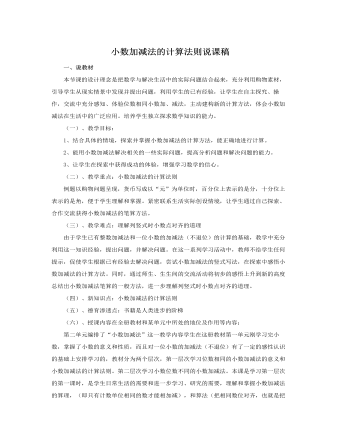
人教版新课标小学数学四年级下册小数加减法的计算法则说课稿
(3)引导总结小数加减法计算方法。引导概括出:计算小数加减法时要把相同数位上的数对齐,也就是要把小数点对齐。(4)看书36页 读小数加减法计算方法(三)拓展练习:1.用竖式计算 4.37+2.93 7.54+6.84【设计意图】练习的目的是巩固算法,同时暴露新的认知冲突,计算结果末尾有“0”,正确处理“0”的问题。学生发现问题,提出解决办法,教师引导学生根据小数的性质,正确认识和掌握计算结果末尾有“0”的时候要化简,即划掉末尾的“0”的问题。2.解决实际问题课件出示【设计意图】解决身边的问题,体会新知识源于生活,服务于生活。在解决问题中使学生进一步理解小数加减法的意义,正确计算小数加减法,掌握新的本领。(四)、课堂小结:分为两部分,先看书36页,整理所学知识;再由学生谈收获、谈体会。归纳总结是否达到知识情感的预定目标。
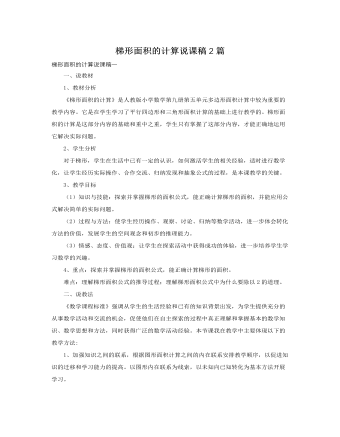
人教版新课标小学数学五年级上册梯形面积的计算说课稿2篇
8、应用公式,尝试计算梯形面积(出示一个基本图形让学生计算)〈这一环节意在让学生主动参与到数学活动中,亲自去体验,让学生运用自己已有的知识,大胆提出假想,共同探讨,互相验证,更强烈地激发学生探究学习的兴趣,更全面、更方便地揭示新旧知识之间的联系。这种让学生在活动中发现、活动中体验、活动中发散、活动中发展的过程,真真正正地体现了以人的发展为本的教育理念。〉(三)、深化巩固1、学习例1(1)、借助教具演示,理解“横截面”的含义。(2)、弄清渠口、渠底、渠深各是梯形的什么?(3)、学生尝试计算横截面积。〈巩固新知是课堂教学中不可缺少的一个过程,这一环节是为了将学生的学习积极性再次推向高潮,能更好地运用公式计算梯形面积,从中培养了学生解决简单实际问题的能力。〉
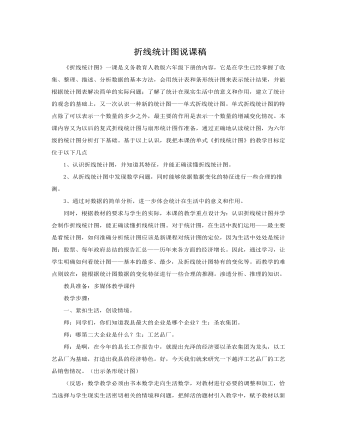
人教版新课标小学数学六年级下册折线统计图说课稿
三、应用知识,解决问题1、练习P63做一做,并根据统计图进行分析和提建议。(1)学生动手制作。(2)用幻灯展示学生作品,并评议。(3)谈自己根据统计图进行分析和提建议2、学生动手绘制折线统计图。(用自己收集的数据进行绘制折线统计图)(1)学生绘制折线统计图。(2)学生谈自己收集数据与绘制折线统计图的目的?(教师选择性地展示学生的作品,并交流)生1:我收集的数据是自己上学期期末考试成绩与这学期第一、二两单元的数学成绩,制图目的是为了清楚地看出自己本学期成绩变化情况。生2:我收集的数据是妈妈店上3月下旬衣服销售情况,目的是为了帮助妈妈如何调整进货。生3:我收集的是今年1—3月份,我家的用电情况,目的是通过观察用电的变化情况来调整用电,尽量做到节约用电。生4:我妈妈是医生,我从妈妈那收集了我7—12岁的身高数据,制折线统计图的目的是为了更好地了解自己的生长情况,并通过这一情况来指导我班同学的饮食。
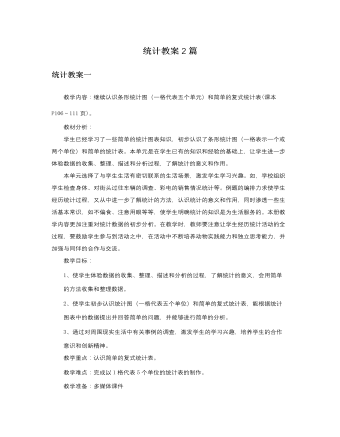
人教版新课标小学数学二年级下册统计教案2篇
2.采用比较简便的方法,师生合作完成“数据的收集与整理(强调数据的准确性),学生独立完成“表格的填写”。3.小组内讨论完成“表格的分析”。4.全班进行反馈。(意在培养独立收集、整理数据的能力,核对数据的准确性,并且扩大提问题的参与面,让学生也能启动智慧、享受快乐;及时反馈信息,调整教学目标)四、全课总结1.通过今天的学习,同学们有哪些收获?2.应用延伸。(课本第112页练习二十二第1题)五、布置作业教后反思统计是日常生产生活中常用和实用的工具,因此统计也是小学生必备的能力之一。但是统计的教学较为枯燥无味,教师往往会轻视统计的教学,忽略学生能力方面的培养。在教学统计时,老师要激发学生学习统计的兴趣,创造各种情景,加强学生统计中的动手实践操作训练,同时在实际生活中加以运用,并逐步加大难度和密度,同时也需要知道,统计教学不要过分地浮夸,多给予学生统计的意义,使其明确学习的目的。
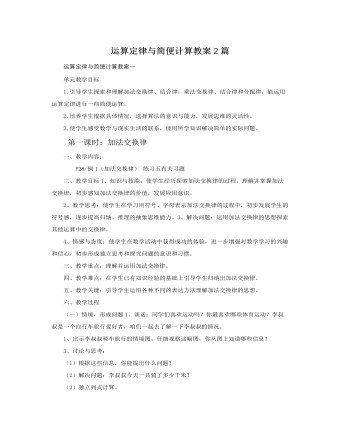
人教版新课标小学数学四年级下册运算定律与简便计算教案2篇
二、教学目标1、知识与技能:使学生经历探索加法交换律的过程,理解并掌握加法交换律,初步感知加法交换律的价值,发展应用意识。2、数学思考:使学生在学习用符号、字母表示加法交换律的过程中,初步发展学生的符号感,逐步提高归纳、推理的抽象思维能力。3、解决问题:运用加法交换律的思想探索其他运算中的交换律。4、情感与态度:使学生在数学活动中获得成功的体验,进一步增强对数学学习的兴趣和信心,初步形成独立思考和探究问题的意识和习惯。三、教学重点:理解并运用加法交换律。四、教学难点:在学生已有知识经验的基础上引导学生归纳出加法交换律。五、教学关键:引导学生运用各种不同的表达方法理解加法交换律的思想。六、教学过程(一)情境,形成问题1、谈话:同学们喜欢运动吗?你最喜欢哪项体育运动?李叔叔是一个自行车旅行爱好者,咱们一起去了解一下李叔叔的情况。1、出示李叔叔骑车旅行的情境图。仔细观察这幅图,你从图上知道哪些信息?

新人教版高中英语必修3Unit 1 Festivals and celebrations-Discovering Useful Structure教学设计
4.That was an experience that frightened everyone. →That was _____________________. 答案:1. taking 2. being discussed 3. in the reading room 4. a frightening experienceStep 6 The meaning and function of V-ing as the predicative动词-ing形式作表语,它通常位于系动词后面,用以说明主语“是什么”或“怎么样”一种表示主语的特质、特征和状态, 其作用相当于形容词; 另一种具体说明主语的内容, 即主语等同于表语, 两者可互换。The music they are playing sounds so exciting. 他们演奏的音乐听起来令人激动。The result is disappointing. 结果令人失望。Our job is playing all kinds of music. 我们的工作就是演奏各种音乐。Seeing is believing. 眼见为实。Step 7 Practice1. It is ________(amaze) that the boy is able to solve the problem so quickly.2. Buying a car is simply _______(waste) money. 3. Please stop making the noise—it’s getting ________(annoy). 4. complete the passage with the appropriate -ing form.La Tomatina is a festival that takes place in the Spanish town Bunol every August. I think many food festivals are __________ because people are just eating. however, this festival is _________ because people don't actually eat the tomatoes. Instead, they throw them at each other! the number of people ________ part in this tomato fight, can reach up to 20,000, and it is a very __________ fight that lasts for a whole hour. The _______ thing is how clean Bunol is after the tomatoes are washed away after the fight. this is because the juice form tomatoes is really good for making surfaces clean!答案:1. amazing 2. wasting 3. annoying4. boring interesting taking exciting amazing

新人教版高中英语必修3Unit 1 Festivals and Celebrations-Listening &Speaking&Talking教学设计
The theme of this section is “Talk about festival activities and festival experiences”.Festival and holiday is a relaxing and interesting topic for students. This part talks about the topic from the daily life of students’. In the part A ---Listening and Speaking, there are three conversations among different speakers from three countries(Japan, Rio and China), where the speakers are participating in or going to participate in the festivals and celebrations. So listening for the relationship among them is a fundamental task. Actually, with the globalization and more international communication, it is normal for Chinese or foreigners to witness different festivals and celebrations in or out of China. In the Conversation 1, a foreign reporter is interviewing a Japanese young girl who just had participated in the ceremony of the Coming-of-Age Day on the street and asking her feeling about the ceremony and the afterwards activities. Conversation 2, Chinese girl Li Mei is witnessing the Rio Carnival for the first time, and her friend Carla gives her some advice on the costumes which enables her to match with the carnival to have a good time. Conversation 3, a Chinese guide is showing a group of foreign visitors around the Lantern Festival and introducing the customs of the festival to them. The three conversations have a strong vitality and insert the festival and cultural elements from different countries. So perceiving the festivals and cultures from different countries is the second task. At the same time, the scripts also insert the targeted grammar --- v-ing as attributive and predicative, which students can perceive and experience in a real context and make a road for the further study. That is the third task. In the Part B--- Listening and Talking, the theme is “Talk about festival experience”, which is the common topic in our daily conversations. During the conversation, Song Lin, a Chinese student, asked Canadian friend Max about how to spend Christmas. In the conversation, Song Lin talked about experience and the feelings during the Chinese Spring Festival, during which there are not only some enjoyable things but some unpleasant things. After the listening, perhaps students find there are some similarities between Christmas and the Chinese Spring Festival as there are some differences in the origins and celebrations. For example, people always visit friends and relatives, decorate their houses, have a big dinner together, chat and give presents to each other.

新人教版高中英语必修3Unit 1 Festivals and Celebrations-Reading for writing教学设计二
Step 3 Analyzing article structureActivity 31. Teachers raise questions to guide students to analyze the chapter structure of this diary and think about how to describe the festival experience. (1)What should be included in the opening/body/closing paragraph(s)?(2)How did the writer arrange his/her ideas?(3)What kind of interesting details did the writer describe?(4)How did the writer describe his/her feelings/emotions during the event?2. Students read and compare the three sentence patterns in activity 2. Try to rewrite the first paragraph of the diary with these three sentence patterns. After that, students exchange corrections with their partners. Such as:●This was my first time spending three days experiencing the Naadam Festival in China’s Inner Mongolia Autonomous Region and it was an enjoyable and exciting experience. ●I'll never forget my experience at the Naadam Festival because it was my first time to watch the exciting Mongolian games of horse racing, wrestling, and archery so closely. ●I'll always remember my first experience at the Naadam Festival in China’s Inner Mongolia Autonomous Region because it was so amazing to spend three days witnessing a grand Mongolian ceremony. Step 4 Accumulation of statementsActivity 41. Ask the students to read the diary again. Look for sentences that express feelings and emotions, especially those with the -ing form and the past participle. Such as:● …horse racing, wrestling, and archery, which are all so exciting to watch. ● some amazing performances● I was surprised to see…● I was a little worried about. . . ● feeling really tiredOther emotional statements:●I absolutely enjoyed the archery, too, but the horse races were my favourite part. ●I'm finally back home now, feeling really tired, but celebrating Naadam with my friend was totally worth it. ●He invited me back for the winter to stay in a traditional Mongolian tent and cat hot pot. I can’t wait!2. In addition to the use of the -ing form and the past participle, the teacher should guide the students in the appreciation of these statements, ask them to memorize them, and encourage them to use them reasonably in writing practice.

新人教版高中英语必修3Unit 1 Festivals and Celebrations-Reading for Writing教学设计一
The topic of this part is “Write about your festival experience”.During the Listening and Speaking and Talking, students are just asked to say out their festival experiences such as the Spring Festival, Mid-autumn Day, but this part students will be asked to write down their own festival experiences. During the reading part, it introduces the Naadam Festival in Inner Mongolia Autonomous Region, which can give students a good example to imitate. Students not only learn the festival, but touch and feel the Inner Mongolian’s character, the spirit and cultural atmosphere, which can help students form the cultural awareness and learn to enjoy and value the diversity of Chinese culture.Concretely, the dairy tells the experience that the author spent the Naadam Festival in Inner Mongolia Autonomous Region with his/her friend. The structure is clear. In the opening paragraph, it introduces the topic of the Naadam Festival and the whole feeling. Then it introduces the items of the festival like the ceremony, wrestling and horse racing. Finally, it summarizes this experience. Because this part is a travel journal, we must guide students pay more attention to these details: 1. use the first person. 2. use the past tense to tell the past thing and use the present or future tense to describe the scenery. 3. use the timeline to tell the development. 4. be careful for the author’s psychology, emotion and feeling, etc.1. Read quickly to get main idea; read carefully to get the detailed information about Naadam Festival.2. Learn the structure of the reading article and language.3. Write an article about a festival experience4. Learn to use the psychology, emotions and feeling in the writing.1. Write an article about a festival experience.2. Use the structure of the reading article and language.